Everything you need to know about this luxurious, crisp fabric from history to modern applications
Table of Contents
- What is Taffeta Fabric?
- History and Origins of Taffeta
- How Taffeta is Made
- Types of Taffeta Fabric
- Taffeta Materials: Silk vs Polyester
- Unique Characteristics and Properties
- Advantages and Disadvantages of Taffeta
- Taffeta vs Other Fabrics
- Uses of Taffeta in Fashion and Beyond
- Sustainable and Eco-Friendly Taffeta
- Complete Care and Maintenance Guide
- Working with Taffeta: Sewing Tips
- Buying Guide: Quality and Price
- Taffeta in Modern Fashion
- Frequently Asked Questions
What is Taffeta Fabric?
Taffeta is a smooth, crisp fabric known for its beautiful sheen and distinctive rustling sound when it moves. The name comes from the Persian word “taftah,” which means “twisted woven,” referring to the special weaving technique that gives taffeta its signature texture.
Unlike soft, flowing fabrics, taffeta has a structured quality that holds its shape wonderfully. Think of it as the fabric equivalent of a perfectly starched shirt that stands up on its own and creates beautiful, dramatic silhouettes. When you touch taffeta, you’ll notice its smooth surface and slight stiffness, which is exactly what makes it perfect for ball gowns and wedding dresses that need to maintain their volume throughout an evening.
Originally made exclusively from silk, today’s taffeta can also be woven from synthetic fibers like polyester and nylon. This makes the fabric more accessible while still maintaining that luxurious look and feel that people love.
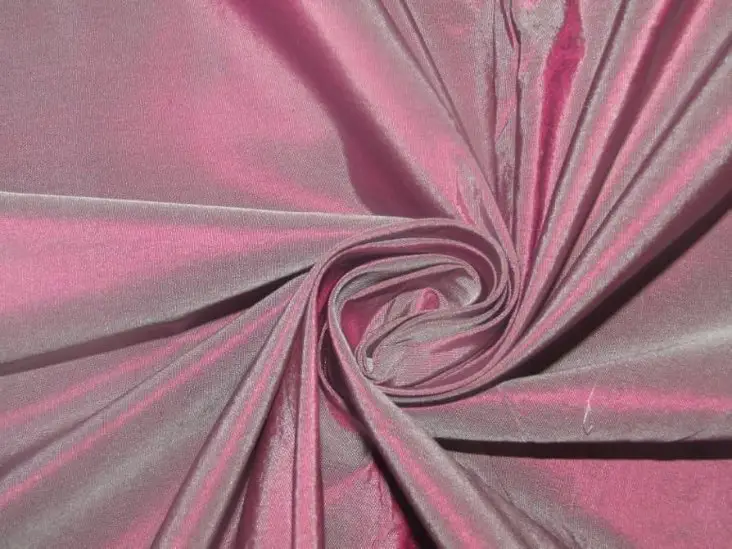
History and Origins of Taffeta
Taffeta has a rich history dating back to the 12th century in the Middle East, specifically in Attabiya, Baghdad. From there, it spread to Persia (modern-day Iran), where it became highly prized by nobility and the wealthy. The fabric’s journey didn’t stop in the Middle East – it eventually made its way to Europe, where it became a symbol of luxury and status.
During the Renaissance period in England, taffeta had some interesting cultural associations. Shakespeare even referenced it in several of his plays, often in connection with fashion and society of the time.
In the 18th century, taffeta played a surprising role in aviation history. On November 4, 1782, Joseph Montgolfier of France used taffeta to construct a small, cube-shaped hot air balloon. The fabric’s lightweight yet durable nature made it perfect for this pioneering experiment.
Fast forward to World War II, and piece-dyed silk taffeta found another unexpected use: parachutes. The fabric’s combination of strength, light weight, and smooth surface made it ideal for life-saving equipment.
By the 1950s, Japan was producing significant amounts of taffeta. Today, India and Pakistan lead global production of raw silk taffeta. In India, particularly around Bangalore, production has shifted from traditional handlooms to mechanical power looms since the 1990s, making taffeta more widely available than ever before.
Famous fashion designers like Coco Chanel, Christian Dior, and more recently Vera Wang have used taffeta to create iconic looks. After falling out of favor in bridal fashion for a while, taffeta is now experiencing a resurgence, with designers embracing its dramatic, structured qualities for modern wedding dresses.
How Taffeta is Made
The magic of taffeta lies in its unique weaving process. Taffeta uses a plain weave technique, which is one of the simplest yet most effective weaving methods. In a plain weave, a single weft thread goes over and under a single warp thread, creating a checkerboard pattern.
What makes taffeta special is that the yarns are tightly twisted as they’re woven together. This twisting creates the fabric’s characteristic crispness and smooth, fine surface. The tighter the twist, the crisper the final fabric will be.
Silk Taffeta Production
For silk taffeta, the process starts with silkworm cocoons. After the silkworms complete their cocoons, they’re boiled to soften the fibers. The cocoons are then carefully unraveled or “reeled” to extract the silk threads. These threads are soaked in a mild solution, then spun into yarn. The yarn can be dyed at this stage (creating yarn-dyed taffeta) or after the fabric is woven (creating piece-dyed taffeta).
Polyester Taffeta Production
Polyester taffeta starts with petroleum-based compounds. Ethylene, derived from petroleum, is reacted with dimethyl terephthalate at high temperatures to produce a monomer alcohol. This monomer is then combined with terephthalic acid to create polyester polymer, which is extruded into fibers and woven into fabric.
Once the raw textile fiber is ready (whether silk or synthetic), it can be formed into taffeta using either hand weaving (traditional method, still used in some regions) or industrial weaving machines (most common today).
Types of Taffeta Fabric
Taffeta isn’t just one single fabric – there are several distinct types, each with unique characteristics and uses. Understanding these different types will help you choose the right taffeta for your project.
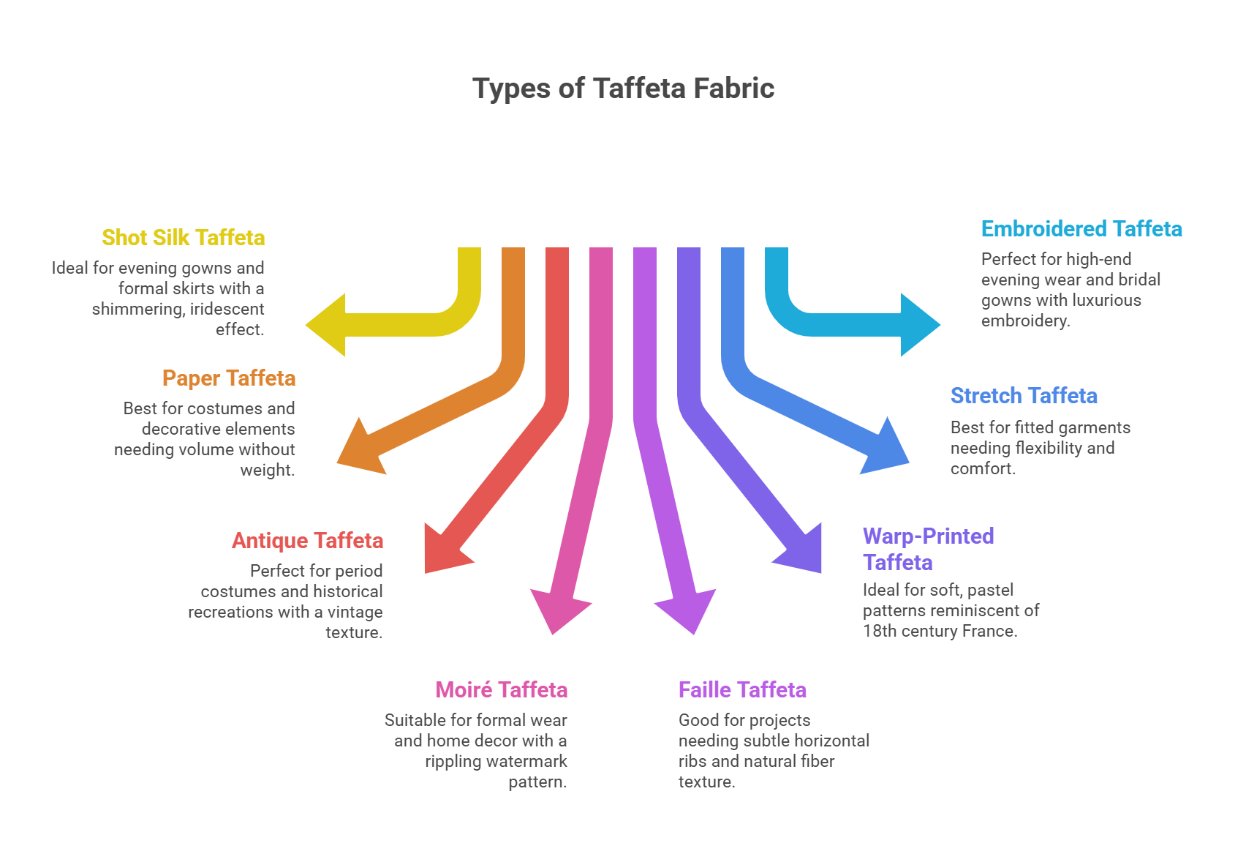
Shot Silk Taffeta
Also known as “changeant” or “changeable taffeta,” shot silk taffeta is one of the most visually striking types. It’s woven with different colored threads for the warp and weft, creating an iridescent effect that shows different colors when viewed from different angles. This shimmering quality was extremely popular with 18th and 19th century nobility. Today, it’s perfect for evening gowns, formal skirts, and any garment where you want that extra visual drama.
Paper Taffeta
As the name suggests, paper taffeta is extremely thin and lightweight, with a crisp, paper-like consistency. Despite its delicate nature, it maintains taffeta’s signature structure. This type works beautifully for costumes, decorative elements, and projects where you need volume without weight.
Antique Taffeta
Antique taffeta is woven from unevenly spun yarns, which creates soft lumps or “slubs” throughout the fabric at regular intervals. Despite these textural irregularities, antique taffeta is quite stiff. The vintage-looking texture makes it perfect for period costumes, historical recreations, and designs that need an authentic, aged appearance.
Moiré Taffeta
Moiré taffeta features a distinctive rippling watermark pattern that looks like waves flowing across the fabric. This effect can be created during the weaving process or by running the fabric through engraved copper rollers. The rippled pattern adds visual interest and texture, making it popular for formal wear and home decor.
Faille Taffeta
Faille taffeta is woven mostly with staple natural fibers (short-length fibers like cotton or wool) in a rib weave, creating subtle horizontal ribs across the fabric. This gives it a slightly different texture compared to smooth taffeta varieties.
Warp-Printed Taffeta
In warp-printed taffeta (also called “Pompadour taffeta” after Madame de Pompadour), the warp threads are printed with colors or patterns before weaving. This creates a soft, pastel pattern with varied colors. This type was especially popular in 18th century France.
Stretch Taffeta
Modern stretch taffeta includes a small amount of elastane (usually around 2-5%) blended into the weave. This addition provides flexibility and comfort while maintaining taffeta’s crisp appearance, making it perfect for fitted or semi-fitted garments that need to move with the body.
Embroidered Taffeta
This luxurious type features delicate embroidery with soutache cord, sequins, beads, or other decorative elements applied to the taffeta base. It’s often used for high-end evening wear and bridal gowns.
Yarn-Dyed vs. Piece-Dyed Taffeta
The timing of the dyeing process affects the final fabric’s characteristics. Yarn-dyed taffeta is dyed before weaving, resulting in a stiffer, crisper fabric perfect for evening gowns and formal wear. Piece-dyed taffeta is woven first, then dyed, creating a softer texture ideal for linings and garments that need more drape.
Taffeta Materials: Silk vs Polyester and Beyond
The material used to make taffeta dramatically affects its properties, price, and best uses. Let’s break down the main options.
Silk Taffeta
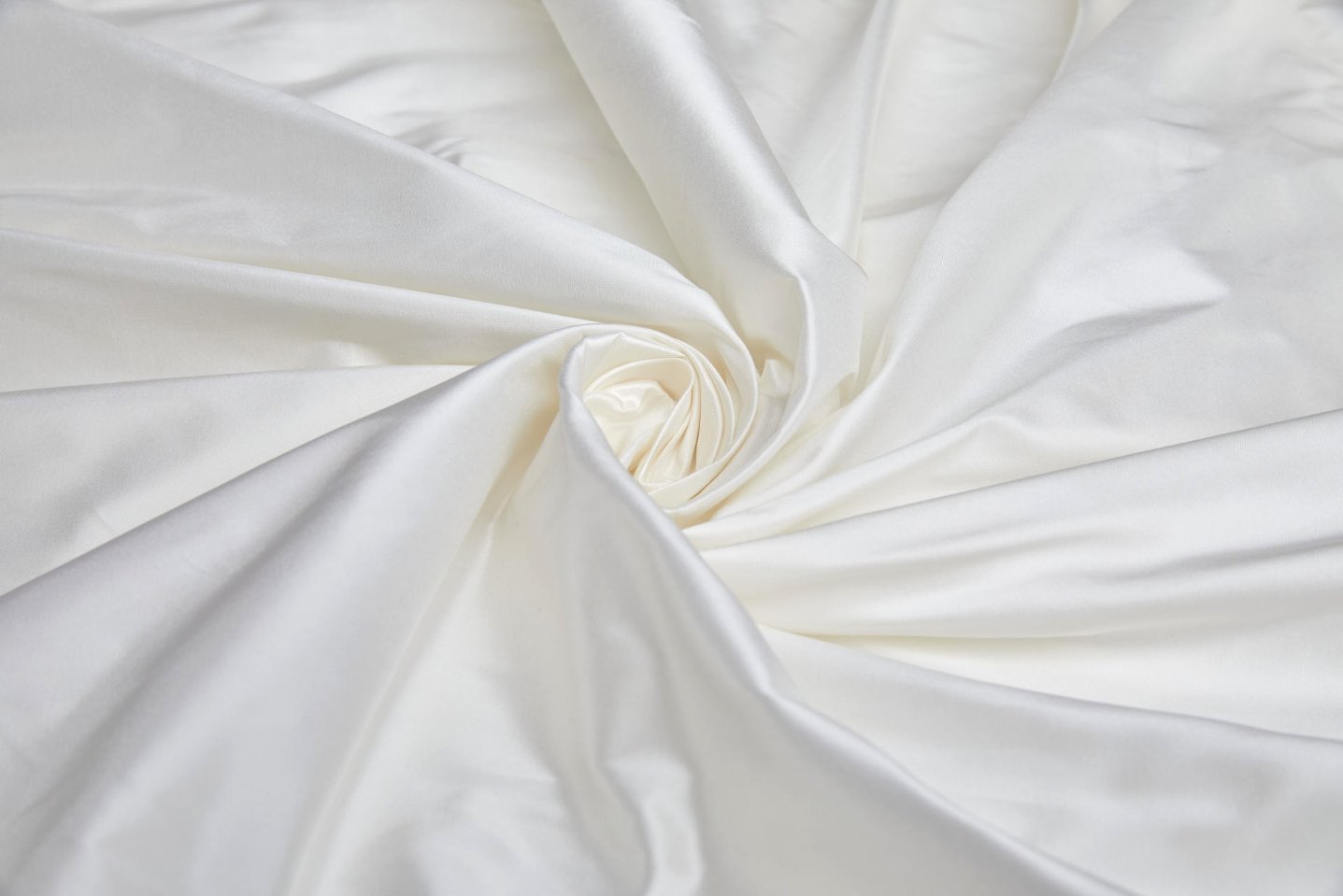
Silk taffeta is the original and most luxurious version. Made from natural silk fibers, it offers unmatched softness, a beautiful natural sheen, and excellent drape. Real silk taffeta has superior breathability compared to synthetic versions, making it more comfortable for extended wear. The natural protein fibers also give silk taffeta a unique luster that synthetic materials struggle to replicate.
However, silk taffeta comes with a premium price tag, typically ranging from $15 to $50 per yard depending on quality. It also requires more careful handling and maintenance. For those seeking the absolute finest quality, especially for wedding gowns and high-end formal wear, silk taffeta remains the gold standard.
If you’re interested in other types of silk fabrics, you might also want to explore silk fabric varieties or learn about organza, another popular silk option.
Polyester Taffeta
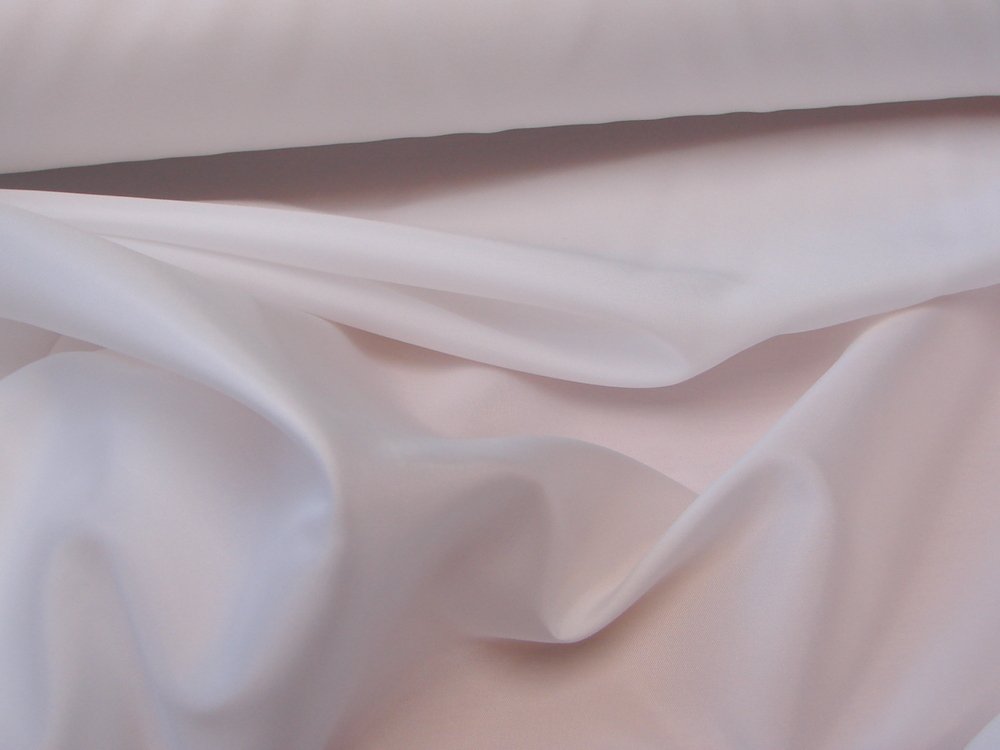
Polyester taffeta is by far the most common type available today. It’s much more affordable than silk, typically costing between $5 and $15 per yard, making taffeta accessible to more people. Modern polyester taffeta does an impressive job of mimicking silk’s appearance and feel.
Polyester taffeta is more durable and easier to care for than silk. It resists wrinkles better, can often be machine washed (check care labels), and isn’t as prone to water staining. The trade-off is that it’s less breathable, which can make it feel warmer to wear, and it doesn’t have quite the same natural luster as silk.
For everyday formal wear, home decor, and projects where budget is a consideration, polyester taffeta offers excellent value. To learn more about polyester fabrics in general, check out this complete polyester fabric guide.
Nylon Taffeta
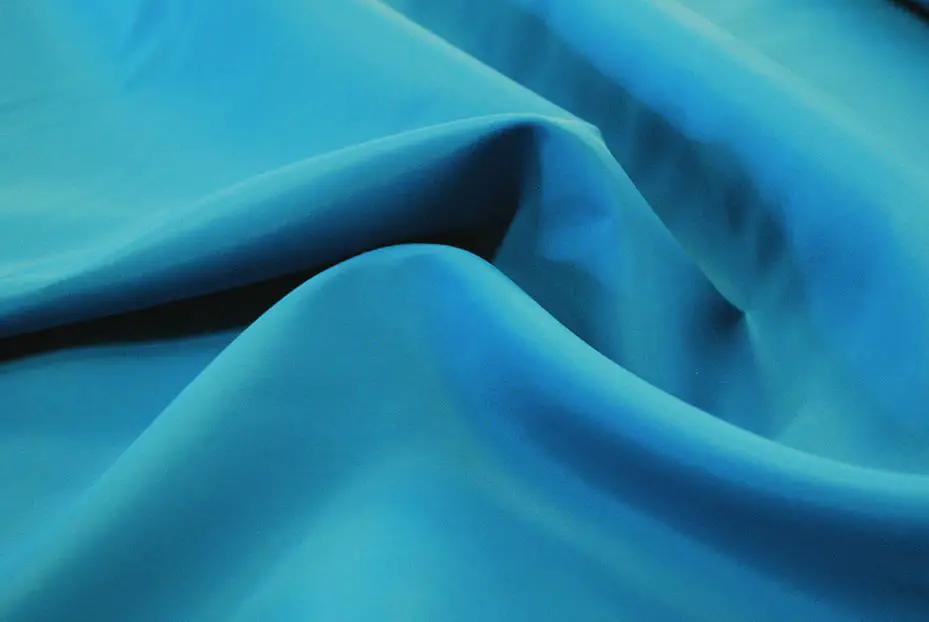
Nylon taffeta is lighter and more flexible than polyester versions. It’s commonly used for technical applications like jacket linings, sleeping bags, umbrellas, and outdoor gear because it offers good water resistance and durability. While it lacks the formal elegance of silk or polyester taffeta for evening wear, it excels in practical applications.
Rayon and Acetate Taffeta
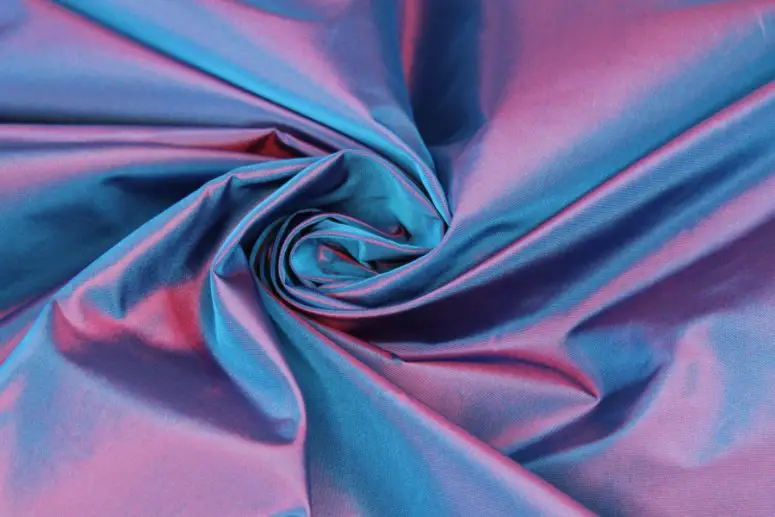
These semi-synthetic options fall somewhere between silk and polyester. Rayon (particularly cuprammonium rayon) was popular in the mid-20th century. Both rayon and acetate taffeta can offer a silk-like appearance at a lower cost than real silk, though they’re less common today than polyester versions.
Recycled Polyester Taffeta
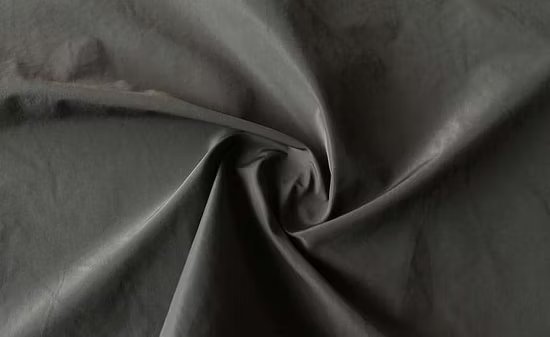
A growing category in the sustainable fashion movement, recycled polyester taffeta is made from post-consumer plastic bottles and other recycled materials. Brands like Conceal and Vivify Textiles are producing GRS-certified recycled taffeta that performs just as well as virgin polyester while reducing environmental impact.
Unique Characteristics and Properties
What makes taffeta instantly recognizable? Several distinctive features set it apart from other fabrics.

The Signature “Scroop”
One of taffeta’s most charming characteristics is its sound. When taffeta fabric rubs against itself or moves, it produces a distinctive rustling noise called “scroop” (a combination of “scrape” and “woop”). This papery, swishing sound adds to the drama of wearing a taffeta gown and is especially pronounced in yarn-dyed silk taffeta.
Crisp Texture and Shape Retention
Taffeta’s tightly twisted yarns create a fabric that holds its shape beautifully. Unlike fabrics that gradually lose their form throughout the evening, taffeta maintains its structure from the first wear to the last. This makes it perfect for garments with volume, like full ball gown skirts or structured bodices.
Lustrous Sheen
Taffeta has a subtle but unmistakable shine that catches the light beautifully. This comes from both the fiber type (silk or polyester) and the tight weave structure. The sheen is less glossy than satin but more pronounced than cotton, giving taffeta an elegant, sophisticated appearance.
Smooth Surface
Run your hand across taffeta and you’ll notice how remarkably smooth it feels. The tightly woven structure creates a fine, even surface with no texture or bumps (except in antique taffeta, where slubs are intentional). Piece-dyed taffeta is particularly soft to the touch.
Vibrant Color Retention
Taffeta holds dye exceptionally well, creating rich, vibrant colors that resist fading over time. The glossy surface enhances color intensity, making even simple solid colors look luxurious. This is why taffeta is available in such stunning jewel tones and deep hues.
Wrinkle Resistance
While not completely wrinkle-proof, taffeta is more resistant to creasing than many other fabrics thanks to its tight weave and structured nature. When wrinkles do appear, they’re usually easier to remove with careful steaming or ironing.
Weight Variations
Taffeta ranges from very lightweight (around 45 g/m² for paper taffeta) to medium weight (up to 150 g/m²). This versatility means you can choose the right weight for your specific project, whether you need airy volume or structured support.
Advantages and Disadvantages of Taffeta
Like any fabric, taffeta has both strengths and limitations. Understanding these will help you decide if it’s the right choice for your project.
Advantages of Taffeta Fabric
- Beautiful Structure: Holds shape perfectly, creating stunning silhouettes for formal wear
- Luxurious Appearance: Natural sheen and crisp texture give an upscale look
- Color Vibrancy: Excellent dye retention means rich, long-lasting colors
- Versatile Weight Options: Available from ultra-light to medium weight
- Good Durability: The tight weave makes it resistant to tearing when handled properly
- Distinctive Character: The rustling sound and unique feel add special charm
- Shape Memory: Doesn’t sag or lose form like softer fabrics
- Multiple Material Options: Available in silk, polyester, or eco-friendly recycled versions
- Professional Results: Creates couture-level finishes in garments
Disadvantages of Taffeta Fabric
- Snags Easily: Fine fibers can catch and pull, creating visible damage
- Limited Breathability: Especially polyester versions can feel hot and don’t absorb moisture well
- Difficult to Sew: Slippery surface makes it challenging for beginners
- Care Requirements: Often needs dry cleaning, especially silk varieties
- Water Sensitivity: Can water spot, particularly silk and lighter colors
- Stiffness: Not comfortable for casual, everyday wear
- Price (for silk): High-quality silk taffeta is expensive
- No Stretch: Doesn’t have flexibility unless elastane is added
- Noise: The rustling can be distracting in quiet settings
- Not Sustainable (virgin polyester): Petroleum-based unless choosing recycled options
Is Taffeta a Nice Fabric?
Yes, taffeta is considered a beautiful, high-quality fabric, particularly for special occasions. Its crisp texture, lovely sheen, and ability to create dramatic silhouettes make it a favorite for wedding gowns, evening wear, and formal events. However, it’s not the best choice for everyday casual wear due to its stiffness and care requirements.
Taffeta vs Other Fabrics
Understanding how taffeta compares to similar fabrics will help you make the best choice for your project.
| Feature | Taffeta | Satin | Organza | Chiffon |
|---|---|---|---|---|
| Texture | Crisp, stiff, textured | Soft, smooth, flowing | Stiff, sheer, crisp | Soft, flowy, lightweight |
| Sheen | Moderate, subtle shine | High gloss, very shiny | Subtle shine, translucent | Matte, no shine |
| Weight | Light to medium | Medium to heavy | Very lightweight | Very lightweight |
| Drape | Structured, holds shape | Fluid, clings to body | Stiff, stands away from body | Flowing, soft drape |
| Transparency | Opaque | Opaque | Sheer | Sheer to semi-sheer |
| Best For | Ball gowns, structured dresses, curtains | Form-fitting evening wear, lingerie | Overlays, veils, structured accents | Flowing dresses, scarves, overlays |
| Typical Price | $5-$50/yard | $10-$35/yard | $8-$30/yard | $5-$25/yard |
Which is Better: Taffeta or Satin?

Neither fabric is objectively “better” – it depends on what you’re making. Choose taffeta for structured, voluminous designs like ball gowns with full skirts that need to hold their shape. The crisp texture creates beautiful architectural forms and works perfectly for garments that should stand away from the body.
Choose satin for sleek, form-fitting designs that need to drape smoothly against the body, like slip dresses or bias-cut gowns. Satin’s fluid nature and higher shine create a more sensual, body-conscious silhouette. For more on satin fabrics, see sateen fabric.
In terms of comfort, satin is generally softer and more pleasant against the skin. Taffeta is lighter in weight but can feel hot due to poor breathability, especially in polyester versions. Satin is heavier and can also trap heat.
What Fabric is Similar to Taffeta?
The fabric most similar to taffeta is probably dupioni silk (also called silk shantung). Like taffeta, dupioni has a crisp texture and natural sheen, though it has characteristic slubs throughout the fabric that create texture. Another similar option is faille, which has a subtle ribbed texture and slightly less sheen than taffeta.
Taffeta vs Cotton
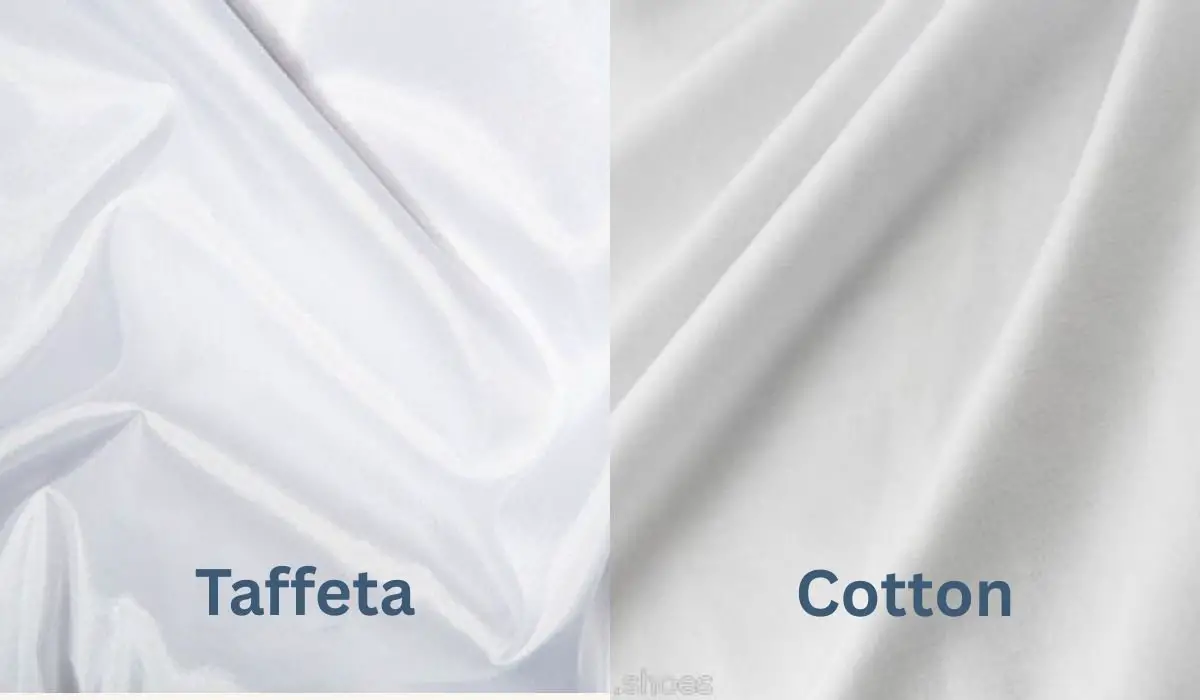
These fabrics couldn’t be more different. Cotton is soft, breathable, absorbent, and comfortable for everyday wear. Taffeta is stiff, has poor moisture absorption, and is reserved for special occasions. Cotton is easy to care for; taffeta requires special attention. Choose cotton for casual, comfortable clothing and taffeta for formal events where structure and elegance matter most.
Uses of Taffeta in Fashion and Beyond
Taffeta’s unique properties make it perfect for certain applications while unsuitable for others. Here’s where taffeta really shines.

Wedding Dresses and Bridal Fashion
Taffeta is experiencing a major comeback in bridal fashion. Designers are embracing its ability to create dramatic, structured wedding gowns with volume and presence. The fabric works beautifully for fitted bodices and full skirts, especially ball gown silhouettes. Shot silk taffeta adds extra visual interest with its color-changing iridescence.
Evening Gowns and Formal Wear
From prom dresses to red carpet gowns, taffeta creates show-stopping formal wear. Its lustrous appearance and ability to hold shape make it perfect for special occasions where you want to make an entrance. The fabric’s natural drama suits evening events perfectly.
Party Costumes and Theater
Taffeta’s crisp structure and visual appeal make it a favorite for costumes, both for parties and stage performances. Paper taffeta works especially well for period costumes, while antique taffeta adds authentic vintage character.
Corsets and Structured Undergarments
The stiff nature of taffeta provides the support needed for corsets and other foundation garments. The fabric holds its shape while creating the desired silhouette, making it functional as well as beautiful.
Linings
Piece-dyed taffeta, which is softer than yarn-dyed versions, makes excellent lining material for jackets and coats. The smooth surface allows outer garments to slide on easily, and the decorative sheen adds a luxury touch inside the garment.
Home Decor
Taffeta’s shape-holding properties make it perfect for home applications. Taffeta curtains create elegant window treatments that maintain their pleats and folds beautifully. The fabric’s sheen adds sophistication to any room. Taffeta also works well for decorative pillows, tablecloths, and upholstery accents where structure is desired.
Accessories
Taffeta is used for evening bags, hair accessories, ribbons, and decorative items where a crisp, luxurious look is needed.
Historical and Technical Uses
Beyond fashion and decor, taffeta has served some interesting purposes throughout history. During World War II, piece-dyed silk taffeta was used to make parachutes. The fabric has also been used in hot air balloons, umbrellas, and even medical experiments for artificial blood vessels due to its unique combination of strength, light weight, and smooth texture.
When to Wear Taffeta
Taffeta is best reserved for formal events, weddings, galas, proms, and special celebrations. The fabric’s dramatic rustling and structured appearance make it less suitable for casual daywear or professional office settings. Think red carpet, not coffee shop.
Sustainable and Eco-Friendly Taffeta Options
As fashion becomes more environmentally conscious, sustainable taffeta options are becoming increasingly available and important.
Recycled Polyester Taffeta
The most exciting development in sustainable taffeta is fabric made from recycled polyester (RPET). This taffeta is produced from post-consumer plastic bottles and other reclaimed materials, diverting waste from landfills and oceans. Companies are now offering GRS-certified (Global Recycled Standard) taffeta that performs identically to virgin polyester versions.
Ocean-bound plastic taffeta is another innovation, made from plastics collected from coastal areas at risk of entering the ocean, including discarded fishing nets and marine debris. This helps address ocean pollution while creating beautiful fabric.
Brands producing eco-friendly taffeta include Conceal (available through bridal fabric suppliers), Vivify Textiles, and various manufacturers offering GRS-certified options. These fabrics typically cost slightly more than virgin polyester but less than silk, making them a middle ground for conscious consumers.
Environmental Impact Comparison
Silk taffeta has both positives and negatives environmentally. While silk is natural and biodegradable, conventional silk production requires significant resources and can involve harmful chemicals in processing. Organic silk production is better but still resource-intensive.
Virgin polyester taffeta is petroleum-based and doesn’t biodegrade, contributing to microplastic pollution when washed. However, polyester requires less water to produce than silk and is more durable, meaning garments last longer.
Recycled polyester offers the best of both worlds: similar performance to virgin polyester with significantly lower environmental impact. It uses less energy, reduces plastic waste, and doesn’t require new petroleum extraction.
PFC-Free Water Repellent Finishes
Some taffeta, especially for outdoor applications, receives water-repellent treatments. Look for PFC-free (perfluorinated chemical-free) options, which avoid harmful forever chemicals while still providing water resistance. Learn more about DWR coatings and water-resistant fabrics.
Making Sustainable Choices
When shopping for taffeta, look for:
- GRS certification (proves recycled content)
- OEKO-TEX certification (ensures no harmful chemicals)
- Clear information about fiber sources
- Brands committed to transparency
- Quality over quantity – buy less but better
Complete Care and Maintenance Guide
Proper care is essential for maintaining taffeta’s beauty and extending its life. The care requirements vary significantly depending on whether you have silk or synthetic taffeta.
Quick Care Summary
Silk Taffeta: Dry clean only for best results. If hand washing, use cold water and gentle detergent, never wring or twist.
Polyester Taffeta: Many can be hand washed carefully in cold water. Always check the care label first.
Both Types: Keep away from direct heat, avoid bleach, store in breathable bags, and handle carefully to prevent snags.
Can I Machine Wash Taffeta?
For silk taffeta, machine washing is not recommended as the agitation and rough movement can damage the delicate fibers, leading to fraying, distortion, and loss of the fabric’s characteristic texture and sheen. Even on gentle cycles, the risk is too high.
Some polyester taffeta garments may be machine washable, but you must check the care label. If machine washing is allowed, use cold water, the gentlest cycle available, place the item in a mesh laundry bag for protection, and remove it immediately after washing to prevent wrinkles.
How to Hand Wash Taffeta
If you must wash taffeta at home, hand washing is the safest method:
Hand Washing Steps
- Fill a clean basin with cold or lukewarm water (never hot)
- Add gentle detergent – just a few drops of mild, pH-neutral detergent or baby shampoo. For silk, avoid alkaline detergents.
- For stains: Add a pinch of borax for colored silk taffeta, or use hydrogen peroxide and a few drops of ammonia for white silk taffeta
- Submerge the fabric and gently agitate with your hands. Don’t rub, scrub, or twist
- Soak for 5-10 minutes maximum
- Rinse thoroughly in cold water until all detergent is removed
- Remove excess water by gently pressing between your hands or rolling in a clean white towel. Never wring or twist
- Lay flat to dry on a clean towel in a well-ventilated area away from direct sunlight and heat sources
Is Taffeta Dry Clean Only?
Most taffeta, especially silk varieties and formal garments with linings or embellishments, should be professionally dry cleaned. The dry cleaning process avoids water damage, prevents color bleeding, and properly maintains the fabric’s structure. While this adds to maintenance costs, it’s the safest way to clean taffeta and preserve its quality.
Stain Treatment
Never spot-treat stains on taffeta, as this can cause visible spotting or rings. For oil stains, immediately sprinkle cornstarch or talcum powder on the area to absorb the oil, leave for several hours, then brush off gently before dry cleaning. For other stains, take the garment to a professional cleaner as soon as possible and point out the stain’s location.
Does Water Stain Taffeta?
Yes, water can leave marks on taffeta, especially silk taffeta and lighter colors. Water spots occur because the water changes how the fabric’s fibers reflect light. If taffeta gets wet, blot (don’t rub) immediately with a clean, dry cloth and take it to a professional cleaner.
Can Taffeta Get Wet?
While taffeta won’t dissolve in water, it’s best to keep it dry. Brief exposure to light rain won’t ruin the fabric, but extended wetness can cause water spots, loss of crispness, and potential color bleeding. If a taffeta garment does get wet, hang it to air dry away from heat sources, then have it professionally cleaned to restore its appearance.
Ironing and Steaming Taffeta
Can Taffeta be Ironed?
Yes, but with extreme caution. For silk taffeta, iron while still slightly damp using the lowest heat setting. For polyester taffeta, use the “nylon” or synthetic setting. Always use a pressing cloth between the iron and the fabric to prevent shine marks, scorching, or melting. Never apply direct steam, as it can cause water spots.
Can You Use a Steamer on Taffeta Fabric?
Steaming is tricky with taffeta. While it can work for removing wrinkles, you must be careful not to get the fabric too wet, as this can cause water spots. Hold the steamer at least 6 inches away from the fabric and use quick passes rather than prolonged steam exposure. For valuable garments, professional pressing is safer.
Does Taffeta Wrinkle Easily?
Taffeta is fairly wrinkle-resistant compared to softer fabrics due to its tight weave and structure. However, when wrinkles do form, they can be quite noticeable because of the fabric’s crisp nature. Proper storage and careful handling help prevent wrinkles in the first place.
Does Taffeta Shrink When Washed?
Silk taffeta is generally shrink-resistant when properly cared for with cold water. Polyester taffeta doesn’t typically shrink. However, hot water or high heat from dryers can cause any taffeta to shrink, lose its shape, or become damaged. This is another reason why professional dry cleaning is recommended.
Can You Put Taffeta in the Dryer?
No, never put taffeta in a dryer. The high heat can cause shrinkage, damage the fibers, melt synthetic versions, and destroy the fabric’s structure and sheen. Always air dry taffeta by laying it flat or hanging it carefully.
Storage
Store taffeta garments in breathable cotton garment bags (never plastic, which traps moisture and can cause mildew). Use padded hangers for lighter items to prevent shoulder bumps. For heavy taffeta garments, fold carefully with acid-free tissue paper at the folds to prevent creasing. Store in a cool, dry place away from direct sunlight, which can fade colors over time.
Working with Taffeta: Sewing Tips
Taffeta can be challenging to sew, but with the right techniques, you can achieve professional results. Here’s what you need to know.
Learn professional techniques for sewing with taffeta and satin fabrics
Before You Start
Pre-wash the fabric (only if you plan to wash the finished garment) to reduce stiffness and test for colorfastness. However, many sewers skip pre-washing formal taffeta since these garments are typically dry-cleaned.
Work in a clean space because taffeta is susceptible to staining. Keep food, drinks, and pens away from your work area. For more guidance on working with delicate fabrics, professional sewing resources can be helpful.
Cutting Taffeta
Use sharp fabric scissors or a rotary cutter with a new blade. Dull blades can snag the fabric. Cut with clean, smooth strokes and avoid sawing motions. For iridescent or shot taffeta, pay attention to nap direction and mark all pattern pieces so they’re cut in the same direction.
Marking and Pinning
Taffeta is prone to marking and pinholes, so be careful with how you mark your fabric. Never use water-soluble pens, wax, or chalk, as these can stain. Instead, use tailor’s tacks, thread tracing, or very light marks with a fabric marker on the seam allowance only.
Use fine pins (silk pins work well) and pin only within the seam allowances where holes won’t show. For important projects, consider using fabric clips instead of pins to avoid any holes.
Needle Selection
Use sharp, fine needles designed for lightweight fabrics. A universal 60/8, 70/10, or 80/12 needle works well for most taffeta. Replace your needle if it’s dull, as even slightly dull needles can snag taffeta’s fine fibers.
Thread
Polyester or all-purpose thread works best for most projects. Match thread weight to your needle size. For high-quality results, use fine thread for delicate taffeta.
Machine Settings
Before sewing your project, test your machine settings on fabric scraps:
- Stitch length: Slightly longer than normal (2.5-3.0mm) to prevent puckering
- Tension: May need slight adjustment; test on scraps
- Presser foot: Use a straight stitch foot or roller foot to help feed slippery fabric evenly
- Speed: Sew slowly and steadily for better control
Handling Slippery Fabric
Taffeta’s smooth surface can be tricky to manage. Keep the fabric taut (but not stretched) while sewing to prevent puckering. Use tissue paper on top of the fabric while stitching, then tear it away afterward. This gives the presser foot something to grip.
Seam Finishing
Finish seams properly to prevent fraying. French seams work beautifully with taffeta and give a professional finish. Alternatively, use a serger or zigzag the edges before seaming. For more on seam techniques, check out French seam tutorials or flat-fell seam guides.
Pressing
Press as you sew, but be careful. Use low heat and always use a pressing cloth. Press seams from the wrong side when possible. Avoid creating shine marks by not pressing too hard or too long in one spot. Never use steam directly on taffeta.
Buying Guide: Quality, Price, and Where to Shop
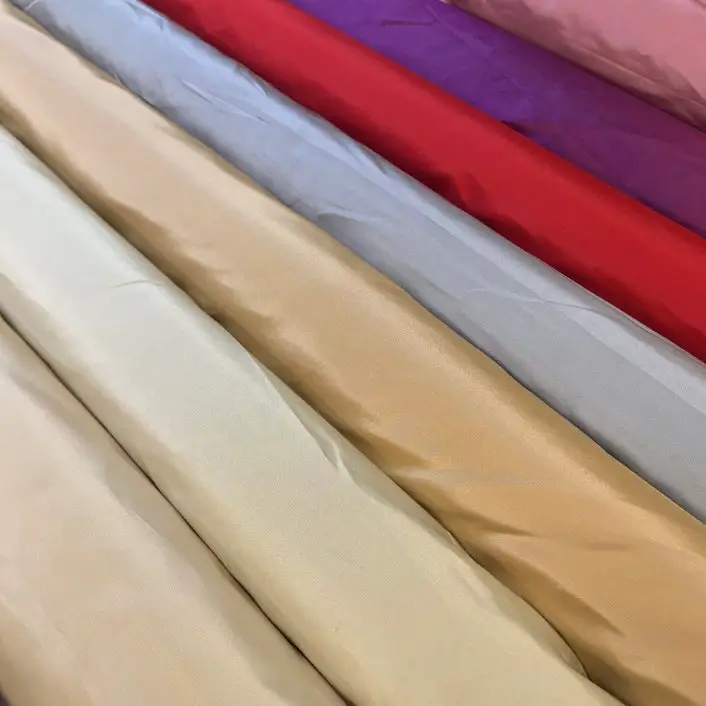
Is Taffeta an Expensive Fabric?
The price of taffeta varies dramatically based on the fiber content and quality. Polyester taffeta is quite affordable at $5-$15 per yard, making it accessible for most projects. Silk taffeta is considerably more expensive, ranging from $15-$50+ per yard depending on quality, with premium options costing even more.
Is Taffeta a Cheap Fabric?
This depends on what you’re comparing it to. Polyester taffeta is budget-friendly compared to many formal fabrics, but taffeta maintains a luxury appearance regardless of price. Even affordable polyester taffeta looks expensive when made up into garments. Silk taffeta definitely isn’t cheap; it’s a premium fabric with a price to match.
Quality Indicators
When shopping for taffeta, look for these signs of quality:
- Even weave: Hold the fabric up to light – you shouldn’t see loose or uneven areas
- Consistent color: No fading, streaks, or variations
- Smooth surface: No pilling, snags, or rough areas (except in antique taffeta where slubs are intentional)
- Good body: The fabric should feel crisp and substantial, not limp
- Nice drape: Despite stiffness, quality taffeta hangs well
- Fingernail test: Gently scratch the surface with your fingernail – if the warp yarn separates easily, it’s a loose weave that may unravel
Where to Buy
For high-quality taffeta, consider:
- Specialty fabric stores: Often carry better selection and quality
- Online fabric retailers: Wider selection but can’t feel fabric before buying
- Bridal fabric suppliers: Excellent source for silk taffeta and specialty types
- High-end manufacturers: Belinac (France), Frontline (Switzerland), Carnet (Italy), Taroni (Italy), Ruffo Coli (Italy)
Always order samples when possible, especially for significant purchases. Online retailers often provide swatches so you can feel the fabric and see colors in person before committing.
Taffeta in Modern Fashion
After years of softer, more casual styles dominating fashion, structured fabrics like taffeta are making a major comeback. Here’s what’s happening in 2025.
Bridal Fashion Resurgence
Taffeta wedding dresses are back in a big way. Designers are moving away from the soft, flowing bohemian styles that dominated the past decade and embracing dramatic, architectural silhouettes. Modern brides are choosing taffeta for its ability to create statement gowns with volume, structure, and presence.
Contemporary designers are updating classic taffeta looks with modern touches: clean lines, minimalist details, and unexpected color choices beyond traditional white and ivory. Metallic taffetas and jewel tones are particularly popular for fashion-forward brides.
Red Carpet and Evening Wear
Taffeta is a red carpet favorite for its ability to create memorable, photograph-worthy moments. The fabric’s sheen catches light beautifully on camera, and its structured nature creates clear, defined silhouettes that stand out.
Sustainable Luxury
The introduction of GRS-certified recycled polyester taffeta is allowing eco-conscious consumers to enjoy taffeta’s luxury without the environmental guilt. This trend is particularly strong in bridal fashion, where brides want both beauty and sustainability.
Color Trends
While classic colors remain popular, there’s growing interest in:
- Deep jewel tones (emerald, sapphire, ruby)
- Metallics (gold, silver, bronze)
- Unexpected pastels
- Bold monochromes (black taffeta gowns are having a moment)
Is Taffeta a Summer Fabric?
Taffeta is not ideal for hot summer weather, especially polyester versions. The fabric doesn’t breathe well and doesn’t absorb moisture, which can make you feel hot and sweaty in warm conditions. Silk taffeta is slightly better than polyester due to natural fiber’s superior breathability, but it’s still not the most comfortable choice for summer heat.
That said, taffeta can work for summer evening events where you’ll be in air-conditioned spaces. The lightweight nature of some taffetas (especially paper taffeta) makes them more tolerable than heavier formal fabrics like velvet or heavy satin. For comfortable summer fabrics, explore summer fabric options or chiffon instead.
Is Taffeta Good for Hot Weather?
No, taffeta is not the best choice for hot weather. Its poor breathability and moisture-wicking properties make it feel warm and can trap heat against your body. If you need a formal fabric for a hot-weather event, consider lighter options like georgette or silk charmeuse instead.
Frequently Asked Questions
Is taffeta 100% polyester?
Not always. While most taffeta available today is made from polyester, taffeta can also be made from silk, nylon, rayon, acetate, or blends of these fibers. The material used depends on the specific product and manufacturer. Always check the fiber content label to know exactly what your taffeta is made from.
What does taffeta fabric feel like?
Taffeta feels smooth, crisp, and slightly stiff to the touch. Unlike soft, flowing fabrics, taffeta has noticeable structure and body. The surface is very smooth and even, with a subtle sheen. When you handle it, you’ll notice it makes a characteristic rustling sound. Piece-dyed taffeta tends to feel softer than yarn-dyed versions, while silk taffeta feels more luxurious than polyester.
What is another name for taffeta fabric?
Taffeta is sometimes called “shot silk” (specifically for iridescent shot silk taffeta) or “paper taffeta” (for ultra-thin versions). Historically, it was also known as “taffety” or “taffata.” Warp-printed taffeta is sometimes called “Pompadour taffeta” or “chiné.” These names refer to specific types rather than alternative names for all taffeta.
Is taffeta a sheer fabric?
No, taffeta is not sheer. It’s an opaque fabric that you can’t see through. This is one of the key differences between taffeta and similar fabrics like organza, which is sheer. Even the thinnest paper taffeta is opaque, though it’s very lightweight. If you need a sheer fabric with similar crispness, organza would be a better choice.
Does taffeta make you sweat?
Polyester taffeta can make you feel warm because it doesn’t breathe well and doesn’t absorb moisture. The fabric traps heat and moisture against your skin, which can lead to sweating, especially in warm environments or if you’re moving around a lot. Silk taffeta breathes better than polyester but still isn’t as comfortable as natural, absorbent fabrics like cotton or linen. This is why taffeta is best saved for special occasions in climate-controlled settings rather than extended outdoor wear.
Which is better: polyester or taffeta?
This is like asking “which is better: cotton or pants?” Taffeta is a type of fabric weave, while polyester is a fiber material. Polyester taffeta combines both; it’s taffeta fabric made from polyester fibers. You might be asking whether polyester taffeta or silk taffeta is better, which depends on your needs. Polyester taffeta is more affordable, easier to care for, and more durable. Silk taffeta is more luxurious, breathes better, and has superior drape and sheen. For everyday formal wear, polyester taffeta offers great value. For once-in-a-lifetime garments like wedding dresses, silk taffeta is worth the investment.
Conclusion
Taffeta fabric holds a special place in the world of textiles. Its combination of crisp structure, beautiful sheen, and distinctive character makes it irreplaceable for certain applications, particularly formal wear and special occasion garments. From its Persian origins in the 12th century to its modern resurgence in bridal fashion, taffeta has proven its lasting appeal.
The fabric’s unique properties, including its shape retention, lustrous appearance, and signature rustling sound, create garments that make a statement. Whether you choose traditional silk taffeta for its unmatched luxury or opt for more practical polyester versions, or even eco-friendly recycled options, taffeta offers something special that softer fabrics simply can’t match.
Key Takeaways
Choose taffeta when you want: Structure and volume in formal garments, dramatic silhouettes that hold their shape, a fabric with luxurious appearance for special occasions, or material for structured home decor like curtains.
Avoid taffeta for: Casual everyday wear, hot weather outdoor events, garments that need to be machine washed frequently, or projects requiring soft drape and flexibility.
Care is essential: Taffeta requires special handling to maintain its beauty. Most taffeta benefits from professional dry cleaning, though careful hand washing may work for some pieces. Always avoid high heat, harsh chemicals, and rough treatment.
Consider sustainability: If environmental impact matters to you, look for GRS-certified recycled polyester taffeta, which offers the beauty of traditional taffeta with significantly lower environmental cost.
Know your type: Understanding the different types of taffeta, from shot silk to paper taffeta to antique varieties, helps you choose exactly the right fabric for your specific project.
Budget smartly: Silk taffeta is beautiful but expensive ($15-$50+ per yard). Polyester taffeta ($5-$15 per yard) offers excellent value and performs well for most applications. Don’t feel you must use silk to achieve beautiful results.
Respect the challenges: Taffeta isn’t the easiest fabric to work with. It can snag, requires careful sewing, and needs special care. But the results – stunning formal wear, dramatic evening gowns, elegant curtains – make the extra effort worthwhile.
Whether you’re planning a wedding, preparing for a formal event, or creating home decor that makes a statement, taffeta offers unique qualities that few other fabrics can match. With proper knowledge of its characteristics, care requirements, and best uses, you can work with this beautiful fabric confidently and create pieces that truly shine.
The resurgence of taffeta in modern fashion, combined with new sustainable options, means this historic fabric has a bright future ahead. As more designers rediscover taffeta’s dramatic potential and as technology makes eco-friendly versions more available, we’re likely to see even more beautiful applications of this timeless textile.
